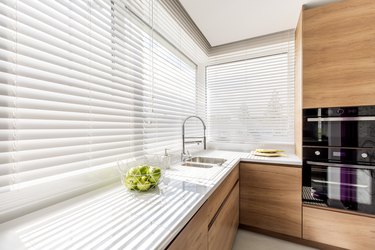
When you think about saving energy at home, you probably think of things like turning down the thermostat, purchasing energy-efficient appliances, adding insulation, and upgrading your home. In fact, there are some simpler ways to save energy at home. One of these is opening and closing window blinds according to the time of day and the season.
Tip
Closing your window blinds on hot summer days blocks the sunlight to keep your home cooler and reduce your energy use. Closing them on cold winter nights cuts down on heat loss, so your home stays warmer with less strain on your furnace.
Video of the Day
When to Close Your Blinds
Closing window blinds at the right times can reduce energy use at home. On hot summer days, when the sun's light shines into some of your windows, it's heating the interior, causing you to turn up the air conditioning and use more energy. By closing the blinds, you keep direct sunlight out of your home and reduce unwanted solar heat gain. Your air conditioner doesn't have to work as hard to cool the space, and you're less likely to adjust the thermostat to a lower temperature. Using blackout blinds can help even more since they block most of the UV light.
Video of the Day
Closing window blinds can also save energy in the winter. During cold winter nights, heat is lost through windows. Closing the blinds adds some insulation to the windows, reducing heat loss during cold periods. Some blinds also reflect heat back into the room.
When to Open Your Blinds
Opening your blinds at the right time also saves energy. On sunny winter days, sunlight shining through windows helps to heat the inside space. This is called passive solar heating and is an effective design strategy to lower energy consumption in buildings. To increase passive solar heat gain, include thermal mass in your interior design. An example of solar mass is tile floors.
Although most people like to keep their blinds closed at night, opening them a little during the hot summer months can allow heat to escape to the cool night air, reducing cooling costs.
Interior or Exterior Blinds
Most blinds are on the interior. The advantages to interior blinds are that they're convenient to operate, install, and replace, but they're also less effective at controlling solar heat gain.
Exterior blinds are usually designed specifically for solar control. They have either manual or remote control operation. Common materials for exterior blinds are wood, vinyl, aluminum, or steel. The advantages of exterior blinds are that they provide better solar control than interior blinds because they are sturdier, have fewer gaps, and they block the sunlight before it passes through the window glass.
Reflective Window Blinds
All window blinds provide shade for windows and can add to the window's insulation value, reducing heat transfer through windows. However, reflective blinds perform better because they reflect light and heat. This is beneficial in summer to keep homes cool, and in winter to reflect interior heat back inside.
Some reflective blinds are reversible, with one side highly reflective and the other highly absorptive. The reflective side should always face the heat. In summer, the reflective side faces out, and in winter it faces in.